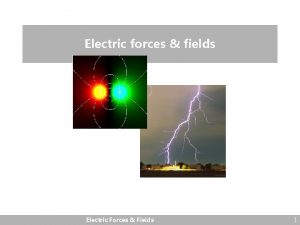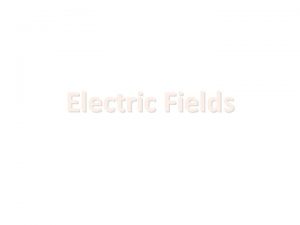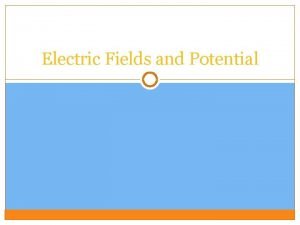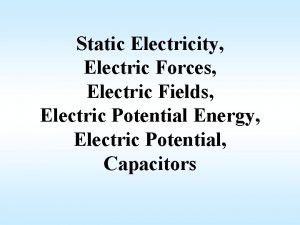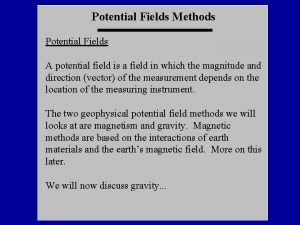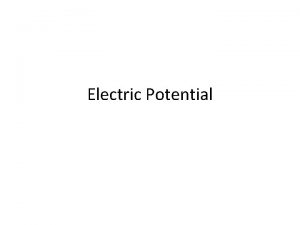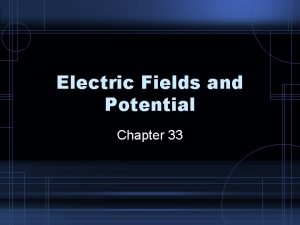Electric Potential Electric Energy Electric fields produce forces











- Slides: 11

Electric Potential Electric Energy • Electric fields produce forces; forces do work • Since the electric fields are doing work, they must have potential energy • The amount of work done is the change in the potential energy • The force can be calculated from the charge and the electric field q E s ds • If the path or the electric field are not straight lines, we can get the change in energy by integration • Divide it into little steps of size ds • Add up all the little steps

The Electric Potential • Just like for electric forces, the electric potential energy is always proportional to the charge • Just like for electric field, it makes sense to divide by the charge and get the electric potential V: • Using the latter formula is a little tricky • It looks like it depends on which path you take • It doesn’t, because of conservation of energy • Electric potential is a scalar; it doesn’t have a direction • Electric potential is so important, it has its own unit, the volt (V) • A volt is a moderate amount of electric potential • Electric field is normally given as volts/meter

Why Electric Potential is useful 1. It is a scalar quantity – that makes it easier to calculate and work with 2. It is useful for problems involving conservation of energy A proton initially at rest moves from an initial point with V = 0 to a point where V = - 1. 5 V. How fast is the proton moving at the end? • Find the change in potential energy V =0 V = -1. 5 V E + • Since energy is conserved, this must be counterbalanced by a corresponding increase in kinetic energy 1. 5 V

The Zero of the Potential We can only calculate the difference between the electric potential in two places • This is because the zero of potential energy is arbitrary • Compare U = mgh from gravity • There are two arbitrary conventions used to set the zero point: • Physicists: Set V = 0 at • Electrical Engineers: Set V = 0 on the Earth • In circuit diagrams, we have a specific symbol V=0 to designate something has V = 0. Anything attached here has V = 0

Potential From a Point Charge r q • Integrate from infinity to an arbitrary distance • For a point charge, the equipotential surfaces are spheres centered on the charge • For multiple charges,

Electric Fields near conductors • The potential for the two spheres ended up the same • The electric fields at the surface are not the same q 1 q 2 • The more curved the surface Very strong electric field here is, the higher the electric field is there • A sharp point can cause charged particles to spontaneously be shed into air, even though we normally think of air as an insulator. • Called “Corona discharge”

The Lightning Rod • Rain drops “rubbing” against the air can cause a separation of charge • This produces an enormous electric field • If electric field gets strong enough, it can cause breakdown of atmosphere • Put a pointy rod on top of the + building you want to protect • Coronal discharge drains away the charge near the protected object + • Lightning hits somewhere else + + + + +

The Van de Graff Generator • Hollow conducting sphere, insulating belt, source of electric charge • Source causes charge to move to the belt • Belt rotates up inside sphere • Charge jumps to conductor inside sphere • Charge moves to outside of sphere • Since all the charge is on the outside of the sphere, process can be repeated indefinitely. -

Electrostatic Precipitator Clean air 50 k. V Dirty air + • Hollow conducting tube with a thin wire hanging down inside it • Dirty air enters at the bottom • Coronal discharge from wire produces lots of O 2 ions • O 2 - ions hit dust particles, giving them charge • Charged dust now flows towards walls • Clean gas flows out the top • Gravity (shaking helps) causes dust to fall to the bottom of the container

Application – Xerographic Copiers • The process of xerography is used for making photocopies • Uses photoconductive materials – A photoconductive material is a poor conductor of electricity in the dark but becomes a good electric conductor when exposed to light

Application – Xerographic Copiers












